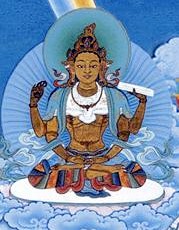Prajnaparamita: Difference between revisions
Jump to navigation
Jump to search
No edit summary |
|||
| Line 18: | Line 18: | ||
All of the prajñaparamita [[sutra]]s can be classified in the | All of the prajñaparamita [[sutra]]s can be classified in the | ||
*[[six mother scriptures]] and | *[[six mother scriptures]] and | ||
*[[eleven son scriptures]]. | *[[eleven son scriptures]]. | ||
In the Tibetan canon, all these texts can be found at the beginning of the Sutra collection of the [[Kangyur]] ([[Toh]] 8-30). | |||
==Notes== | ==Notes== | ||
Revision as of 22:57, 11 November 2020

Prajñaparamita (Skt. prajñāpāramitā; Tib. ཤེར་ཕྱིན་, ཤེས་རབ་ཀྱི་ཕ་རོལ་ཏུ་ཕྱིན་པ་, sherchin; Wyl. sher phyin, shes rab kyi pha rol tu phyin pa) means 'Perfection of Wisdom', or more literally, ‘transcendent wisdom’. It refers to:
- the sixth of the paramitas: perfect non-conceptual wisdom.
- the class of Buddhist literature that was mainly discovered by Nagarjuna in the second century. Its central topic is emptiness.
- the female deity who is the embodiment of transcendent wisdom.
Definition
"Prajnaparamita is the wisdom of directly realizing the non-conceptual simplicity of all phenomena, which has arrived at, or will lead one to, non-abiding nirvana."[1]
Subdivisions
According to the teachings of the Abhisamayalankara, there are four subdivisions:
- natural prajnaparamita
- scriptural prajnaparamita
- path prajnaparamita
- resultant prajnaparamita
Literature
All of the prajñaparamita sutras can be classified in the
In the Tibetan canon, all these texts can be found at the beginning of the Sutra collection of the Kangyur (Toh 8-30).
Notes
- ↑ From The Words of Jikme Chökyi Wangpo by Khenpo Tsöndrü.